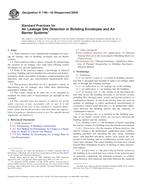Potřebujeme váš souhlas k využití jednotlivých dat, aby se vám mimo jiné mohly ukazovat informace týkající se vašich zájmů. Souhlas udělíte kliknutím na tlačítko „OK“.
ASTM E1186-03(2009)
Standard Practices for Air Leakage Site Detection in Building Envelopes and Air Barrier Systems
Automaticky přeložený název:
Standardní postupy pro vzduchové těsnosti odhalování místo v opláštění budov a Air zábranné systémy
NORMA vydána dne 15.4.2009
Informace o normě:
Označení normy: ASTM E1186-03(2009)
Poznámka: NEPLATNÁ
Datum vydání normy: 15.4.2009
Kód zboží: NS-40778
Počet stran: 7
Přibližná hmotnost: 21 g (0.05 liber)
Země: Americká technická norma
Kategorie: Technické normy ASTM
Kategorie - podobné normy:
Anotace textu normy ASTM E1186-03(2009) :
Keywords:
acoustic method, air barrier system, air leakage, air leakage detection, anemometer method, bubble method, building envelopes, infrared method, smoke trace method, tracer gas method, Acoustical tests, Air leakage testing--building materials/constructions, Air retarder (AR) systems, Anemometers, Building envelopes, Depressurization (pressurization)/infrared method, Infiltration rate, Infrared (IR) analysis, Insulation, Leak testing--building constructions/materials
Doplňující informace
| Significance and Use | ||||||||
|
Air infiltration into the conditioned space of a building accounts for a significant portion of the thermal space condition load. Air infiltration can affect occupant comfort by producing drafts, cause indoor air quality problems by carrying outdoor pollutants into occupied building space and, in hot humid climates, can deposit moisture in the building envelope resulting in deterioration of building envelope components. In cold climates, exfiltration of conditioned air out of a building can deposit moisture in the building envelope causing deterioration of building envelope components. Differential pressure across the building envelope and the presence of air leakage sites cause air infiltration and exfiltration (1). In some buildings, restricting air movement between interior zones of a building may be desired to separate dissimilar interior environments or prevent the movement of pollutants. Although not dealt with specifically in this standard, the detection practices presented can also be useful in detecting air leaks between interior zones of the building. Air leakage sites are often difficult to locate because air flows may be small under the prevailing weather conditions. Wind conditions can aid in air leakage detection by forcing air to enter a building; however, where air is exiting, the building envelope construction may make observations difficult. For these reasons, forced pressurization or depressurization is strongly recommended for those practices which require controlled flow direction. The techniques for air leakage site detection covered in these practices allow for a wide range of flexibility in the choice of techniques that are best suited for detecting various types of air leakage sites in specific situations. The infrared scanning technique for air leakage site detection has the advantage of rapid surveying capability. Entire building exterior surfaces or inside wall surfaces can be covered with a single scan or a simple scanning action, provided there are no obscuring thermal effects from construction features or incident solar radiation. The details of a specific air leakage site may then be probed more closely by focusing on the local area. Local leak detection is well addressed with the smoke tracer, anemometer, sound detection, the bubble detection, and the tracer gas techniques, however these techniques are time consuming for large surfaces. The pressurized or depressurized test chamber and smoke tracer or a depressurized test chamber and leak detection liquid practices can be used in situations where depressurizing or pressurizing the entire envelope is impractical, such as is the case during construction. Both of the practices enable the detection of very small leaks. To perform these practices requires that the air barrier system be accessible. Complexity of building air leakage sites may diminish the ability for detection. For example, using the sound detection approach, sound may be absorbed in the tortuous path through the insulation. Air moving through such building leakage paths may lose some of its temperature differential and thus make thermographic detection difficult. The absence of jet-like air flow at an air leakage site may make detection using the anemometer practice difficult. Stack effect in multistory commercial buildings can cause gravity dampers to stand open. Computer-controlled dampers should be placed in normal and night modes to aid in determining the conditions existing in the building. Sensitive pressure measurement equipment can be used for evaluating pressure levels between floors and the exterior. Monitoring systems in high-tech buildings can supply qualitative data on pressure differences. |
||||||||
| 1. Scope | ||||||||
|
1.1 These practices cover standardized techniques for locating air leakage sites in building envelopes and air barrier systems. 1.2 These practices offer a choice of means for determining the location of air leakage sites with each offering certain advantages for specific applications. 1.3 Some of the practices require a knowledge of infrared scanning, building and test chamber pressurization and depressurization, smoke generation techniques, sound generation and detection, and tracer gas concentration measurement techniques. 1.4 The practices described are of a qualitative nature in determining the air leakage sites rather than determining quantitative leakage rates. 1.5 The values stated in SI units are to be regarded as standard. No other units of measurement are included in this standard. 1.6 This standard does not purport to address all of the safety concerns, if any, associated with its use. It is the responsibility of the user of this standard to establish appropriate safety and health practices and determine the applicability of regulatory limitations prior to use. For specific hazard statements, see Section 6. |
||||||||
| 2. Referenced Documents | ||||||||
|
Doporučujeme:
EviZak - všechny zákony včetně jejich evidence na jednom místě
Poskytování aktuálních informací o legislativních předpisech vyhlášených ve Sbírce zákonů od roku 1945.
Aktualizace 2x v měsíci !
Chcete vědět více informací? Podívejte se na tuto stránku.




 Cookies
Cookies
